Lessons from Twists in Brooklyn Marine Terminal and Coney Island Development Dramas
For Atlantic Yards, does this mean that new promises and safeguards get a "big thing" done in the name of "abundance"? Or is a rethink possible?
Today, after the postponement of five votes, the Brooklyn Marine Terminal Task Force finally approved a New York City Economic Development Corporation (NYC EDC) plan for a contested 122-acre waterfront site in Red Hook and the Columbia Street Waterfront, with housing (now 6,000 units, 40% affordable at an average of 60% of Area Median Income, which is low-income), an improved port, open space, and many promised community benefits.
The proposal — which is backed by $418 million in city, state, and federal investments — will transform the dilapidated marine terminal into a 60-acre, all-electric maritime port that can, once again, serve as a key economic driver for the community and city. In addition to a revitalized port, the plan passed today will also create 6,000 new homes — including over 2,400 permanently-affordable units — as well as at least 28 acres of public space, 275,000 square feet of commercial space, 250,000 square feet of community facility space, and 275,000 square feet of light-industrial and industrial space at discounted rents.
Two key votes
The approval vote required two task force members, Borough President Antonio Reynoso and Council Member Shahana Hanif, to shift their stances. As The City first explained, in a Sept. 18 article:
Among the changes in the plan, [Hanif] secured an increase in funds for affordable housing in her district from $50 million to $75 million, a study to consider restoring a defunct bus route, funds for capital improvements to public schools and parks, and 50 new apartments that would be set aside for public housing residents currently living in Gowanus Houses and Wyckoff Gardens.
The contingencies, and the time period for such pledges, remains unclear. But elected officials, unsurprisingly, would rather approve projects than reject them.
Reynoso got a promise of an RFEI (Request for the Expressions of Interest) to potentially expand port uses beyond the promised 60 acres.
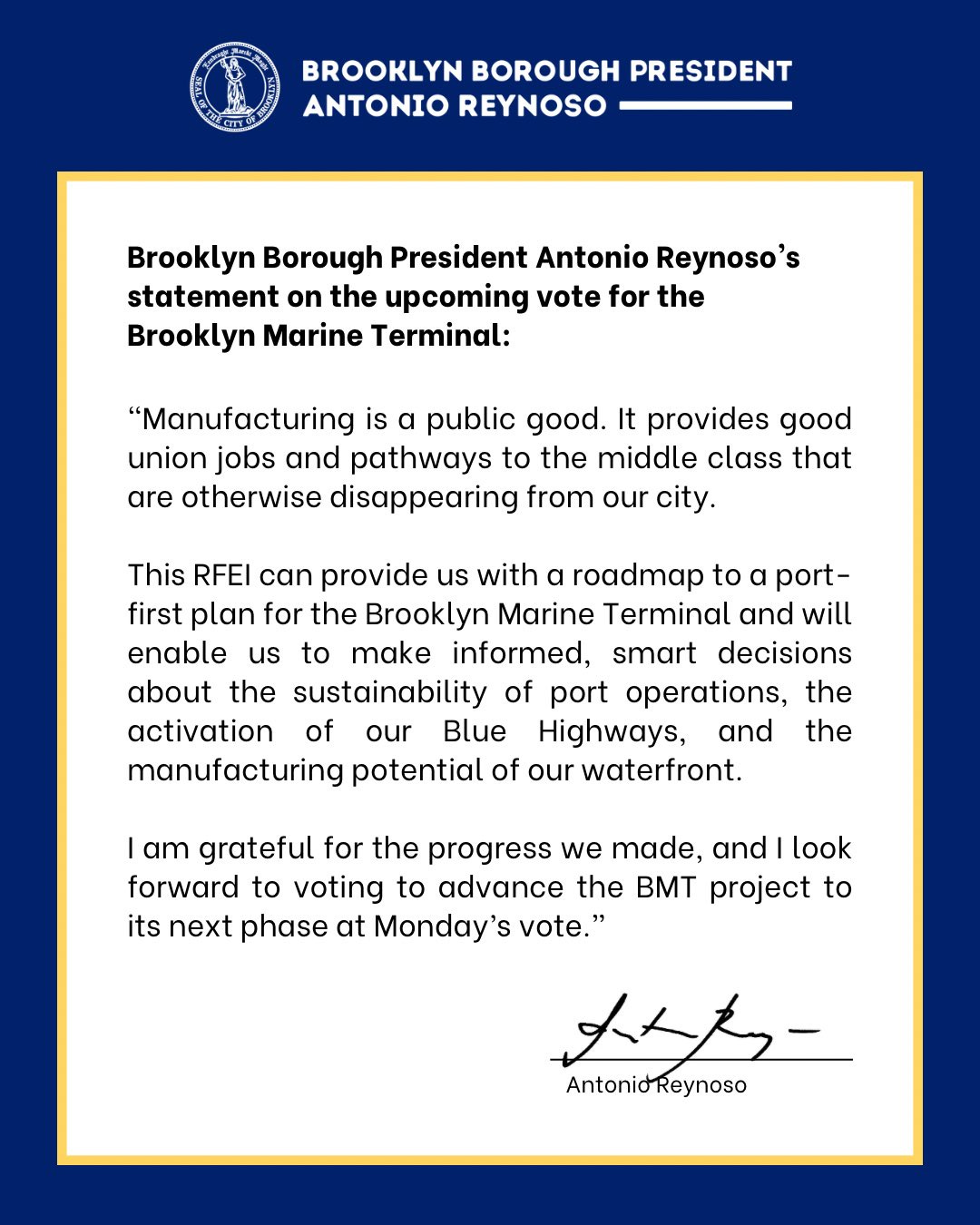
Reynoso went on WNYC’s Brian Lehrer Show Sept. 19 to defend his vote, if not the overall exercise.
"I agree with [a caller] 100 percent that this process has been terrible,” Reynoso said, noting that “this is more a proposal than an actual plan,” and observing that the proposal started with just 30 acres for the port and once proposed 14,000 units of housing.
Of the city agency behind the plan, he acknowledged, "EDC is very good at making things up to get their goals set." (I’ve called the revisions “etch-a-sketch.”)
While critics argued that the city likely will have a new Mayor—Democratic Party nominee Zohran Mamdani has been quiet about the BMT plan, as with Atlantic Yards—Reynoso agreed that the timing is critical, to unlock a $164 federal grant that, with state and city matches, would exceed $400 million.
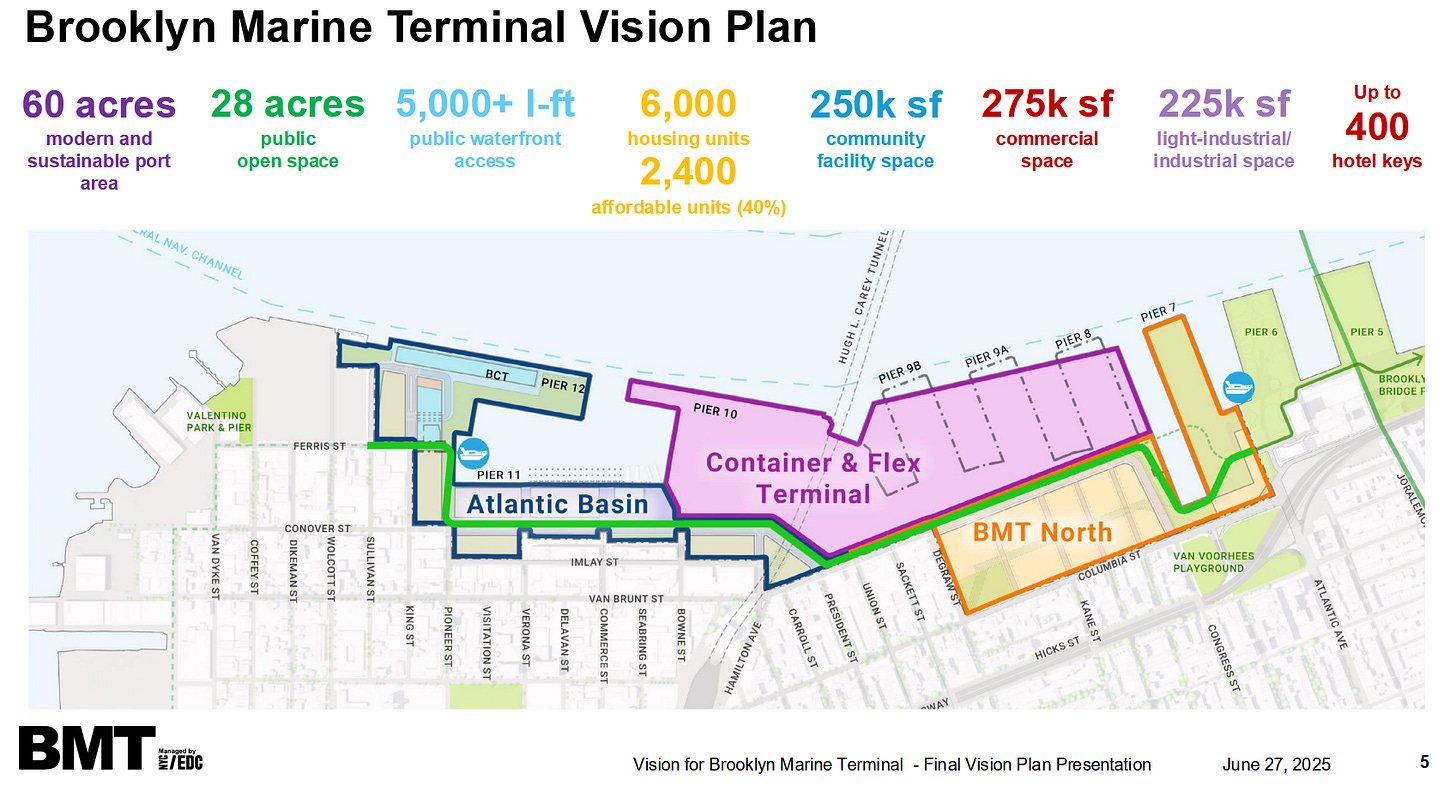
Reynoso echoed the newly popular argument, as in the Ezra Klein/Derek Thompson book Abundance, that sclerotic Democratic-run cities have stifled growth. “I think a big problem we have,” he said, “we can't get big things over the finish line... we process things to death."
One op-ed in favor of the project, from the New York Building Congress head Carlo Scissura in Crain’s New York Business, was headlined Want an 'abundant' New York? Let’s be bold at the Brooklyn Marine Terminal.
As noted by Streetsblog, EDC hopes to have the guiding General Project Plan approved late next year, with construction in phases until 2038. Of course, as Atlantic Yards shows, delays undermine promises of affordability. There would be 3,800 housing units in “BMT North” and 2,200 around the Atlantic Basin.
Skepticism lodged
How, Reynoso was asked, could people be assured the number of affordable units wouldn’t come down?
"That would have to be the work of the BMT board,” he responded. That Brooklyn Marine Terminal Development Corporation (BMTDC) would be controlled by the mayor, with 12 of 23 votes.
In June, as I wrote, Reynoso warned that board would be run by the mayor, who could decide not to pursue accountability.
That warning came in the wake of statements that this structure would help avoid the fate of Atlantic Yards, where a gubernatorially controlled state authority, Empire State Development (ESD), has chosen not to enforce the $2,000/month penalties for missing affordable housing.
Community Board 6, in its supportive message, argued that governance would improve:
Unlike past models, CB6 will have a guaranteed seat at the table in a BMT Development Corporation (BMTDC) to help shape and monitor the implementation of this plan over the next fifteen years and beyond. This is a major departure from previous developments like Atlantic Yards, where public promises gave way to private interests and accountability broke down. In addition to a seat, the plan includes funding for legal support, which will allow stakeholders like CB6 to ensure developers follow through on key commitments, especially around affordable housing.
Yes, a seat at the table and a structure set up to monitor a long-term process are better than not having one. The question is whether the executive in charge, as with the Governor regarding Atlantic Yards, can control the process and ensure enforcement.
Hanif posted some key gains:
Indeed, this language is new (compare p. 47 in the current plan and the June plan):
BMTDC will also ensure that all contract provisions and leases are enforced by NYCEDC, and shall incorporate binding remedies for non-performance or failure to deliver on commitments. Such remedies may include penalties, clawbacks, or other enforceable obligations. BMTDC shall establish independent monitoring and reporting mechanisms.
Still, that doesn’t mean a mayorally controlled board will listen.
Atlantic Yards lessons?
It’s worth noting that two key members of the BrooklynSpeaks coalition, Assemblymember Jo Anne Simon and Fifth Avenue Committee Executive Director Michelle de la Uz, were Task Force members voting no and yes, respectively, each claiming that their vote reflected lessons from Atlantic Yards.
BrooklynSpeaks will have a key voice in the future of Atlantic Yards/Pacific Park.
Simon shared this statement from the dissenters, warning of a lack of transparency and a backroom deals:
This is worth noting:
There are other fundamental flaws like the absence of a financial plan, the refusal of EDC to explore any proposals other than the one they put forward, and the lack of focus on the blue highways. This was intended to be a plan based on Task Force consensus with community input; however, it has been marred by a lack of transparency, backroom deals, heavy-handedness, and artificial deadlines. A revised plan emerged last Thursday without any conversation or review. Task force members were instructed that there would be no more changes to the plan and no community review; this flies in the face of a democratic process.
Also see Streetsblog’s coverage, ‘Government Malpractice’: Marine Terminal Redevelopment Gets Approval Despite Massive Transportation Concerns.
The Brooklyn Eagle reported:
One member of the task force [Hank Gutman, former commissioner of the New York City Department of Transportation] said that the vote was pushed through just as an agreement was being forged with City Hall that would have addressed the serious transportation issues in the BMT area — and also a plan of action for the deteriorating Brooklyn-Queens Expressway Triple Cantilever.
More criticism
Voices of the Waterfront wrote:
After postponing the vote 5 times because they did not have the votes but now that they have cut these “deals” with Brooklyn Borough President Antonio Reynoso and District 39 Council Member Shahana Hanif they are rushing to vote with only days notice and not at the very least having a public hearing to tell the community what is different in this plan that has caused them to change their votes.
On Facebook, Randy Gordon asked, “What qualified (and self-respecting) port operator/developer is going to waste time and money submitting an RFEI proposing a new port-first plan knowing EDC is going to favor its own Vision Plan?”
In support
An argument for support, from Community Board 6:
Brooklyn Community Board 6 is proud to stand with leaders who represent a broad cross-section, drawing on both expertise and community, including Congressman Dan Goldman, Senator Andrew Gounardes, NYCHA tenant leaders, the Cobble Hill Association, the Southwest Brooklyn Industrial Development Corporation, the Fifth Avenue Committee, and the International Longshoremen’s Association. It is particularly impressive and important that the Cobble Hill Association, a neighborhood association often cautious about large-scale change, recognized the value of this plan and chose to support it.
Coney casino falters
After once opposing a casino in Coney Island and then saying he wanted to see the process play out (which helped him get a key endorsement in his Comptroller’s bid), Council Member Justin Brannan, a key vote on the six-person Community Advisory Committee (CAC) that must move the casino proposal (known as The Coney) forward, came out firmly against it.
In a Brooklyn Paper column headlined Coney Island is not for sale, he wrote:
There are things we need in Coney Island, but a casino isn’t one of them. And, let’s be real: casinos exist to make money, not to fix our aging infrastructure or lift families out of poverty. For surrounding businesses, the promise of eight million new customers should be welcome news. But everyone knows that a massive 37-acre casino complex wouldn’t complement our local economy — it would cannibalize it and swallow the People’s Playground whole. Casinos are designed to keep you — and your money — inside. And that might make sense next door to Citi Field, at the Aqueduct Racetrack or Ferry Point — but not in the middle of a small, crowded residential area, where its success would come at the expense of everything else around it.
Brannan’s statement was followed by another “no” pledge, by state Sen. Jessica Scarcella-Spanton, effectively killing the proposal. (Reynoso also announced his opposition. One advisory committee member was already an opponent, and the proposal needed four of six votes.)
To be fair, the casino was proposed near—not in—a crowded residential area, but would overwhelm the established—if significantly underutilized—amusement district and, as critics warned, turning a still iconic place into Atlantic City.
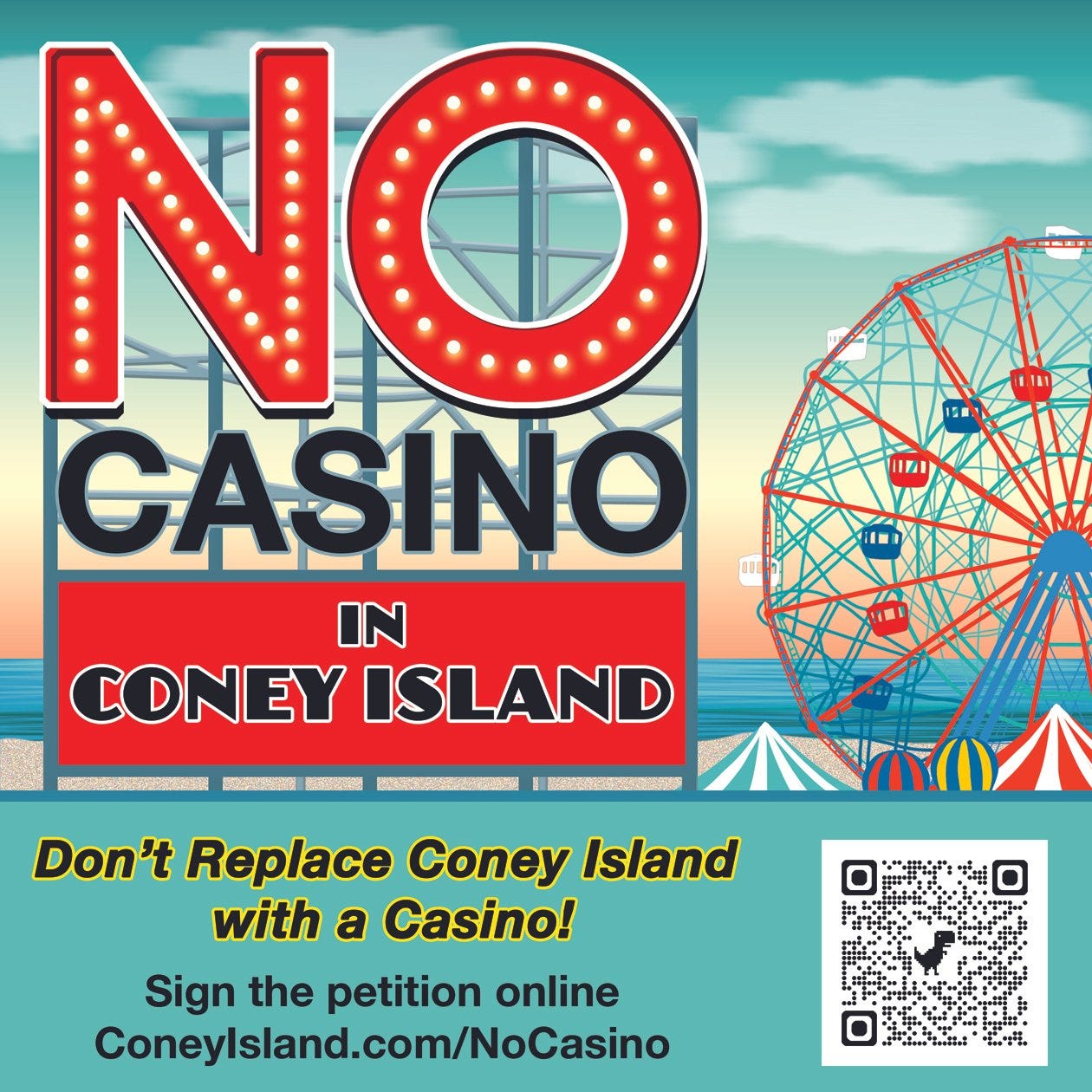
Brannan’s decision came after very contentious public hearings, credible allegations that supporters were paid for their testimony, and even harsh coverage in tabloid Daily Mail: Fury as beach town eyes becoming new Vegas: Thousands of residents fear 'predatory' casino will erase history.
Casino Reports offered Wild scenes at second hearing for what has proven to be the most polarizing NYC casino proposal:
Opponents of the $3.4 billion proposed casino and entertainment venue outnumbered supporters roughly 5-to-1 overall, and it was far more lopsided after an early burst of backers sporting “Yes to The Coney” T-shirts and placards spoke in support. Both
Meanwhile, former Council Member Dominic Recchia, wrote a Daily News a column backing the casino without disclosing he’s a paid supporter.
Coney Island still needs year-round attractions—Brannan mentioned a water park—and jobs, which is why the casino drew some support.
What about Atlantic Yards?
Is the lesson for Atlantic Yards/Pacific Park that “abundance” will win, at least if the community is not as polarized as the one in Coney Island?
Sen. Scarcella-Spanton said she’d follow the majority of the community. With Coney Island, unlike many other contentious land-use fights, that verdict was clear, and it was reasonably plausible to discern the boundaries of “community” in a geographic peninsula.
That’s tougher with a site near the crossroads of Atlantic and Flatbush avenues.
If “abundance” wins, does that mean a new development team led by Cirrus Real Estate Partners and LCOR, which state officials said they hoped to approve this month, will be able to build as big as they want to make the project economically viable, while delivering lower-cost affordable housing?
Remember, as I wrote last year, developer Greenland USA sought, unsuccessfully, to rescue the project by supersizing it.
Expect a recurrence.
What next?
Could there be another way? The bigger ask would be to rethink the whole project. That seems unlikely, given that ESD won’t even enforce the penalties on developer Greenland USA, which apparently will remain as a junior partner in future joint ventures, even though ESD has significant leverage.
Another ask, not unreasonable, would be to require that the project’s financial winner, notably billionaire Joe Tsai’s BSE Global, operator of the arena and owner of the Brooklyn Nets and New York Liberty, cross-subsidize the remaining project, so that public benefits can be assured without letting Cirrus hold sway.
After all, if the arena operator gets a permanent plaza, without the headache of a massive tower built in front of the arena, that assures significant revenues. Shouldn’t BSE Global have to pay for it?


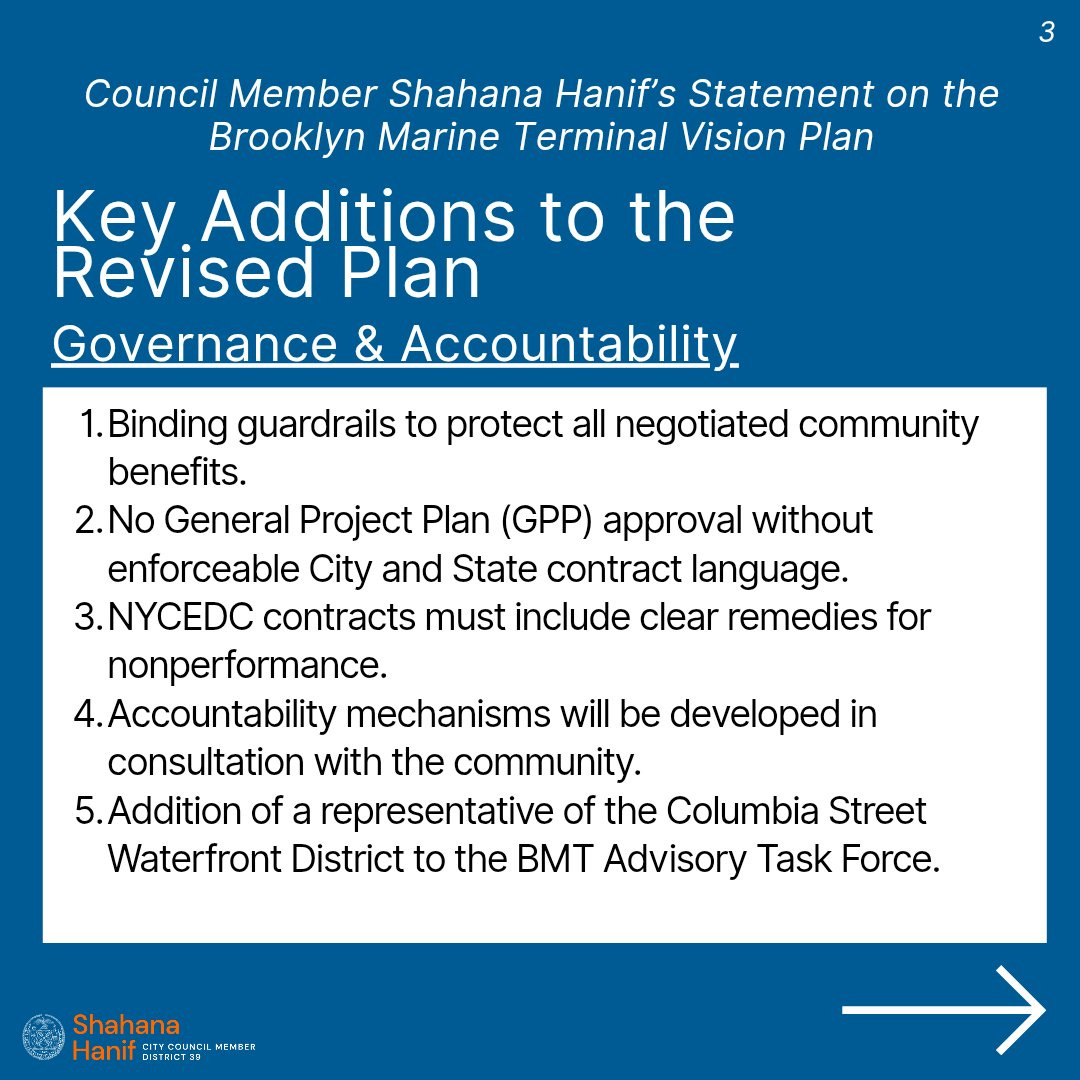
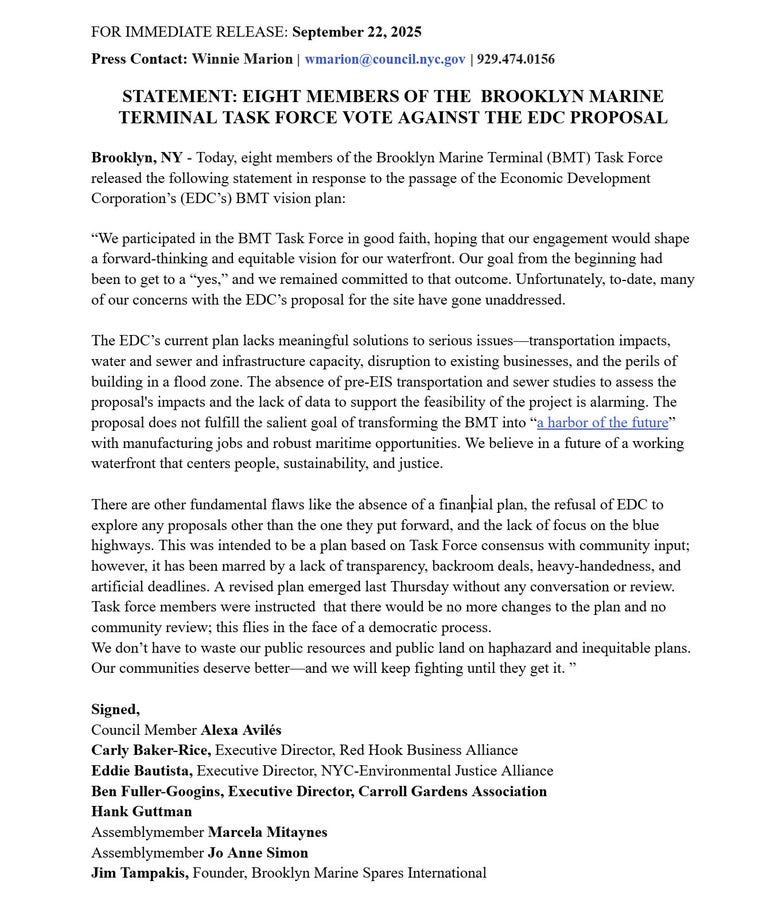
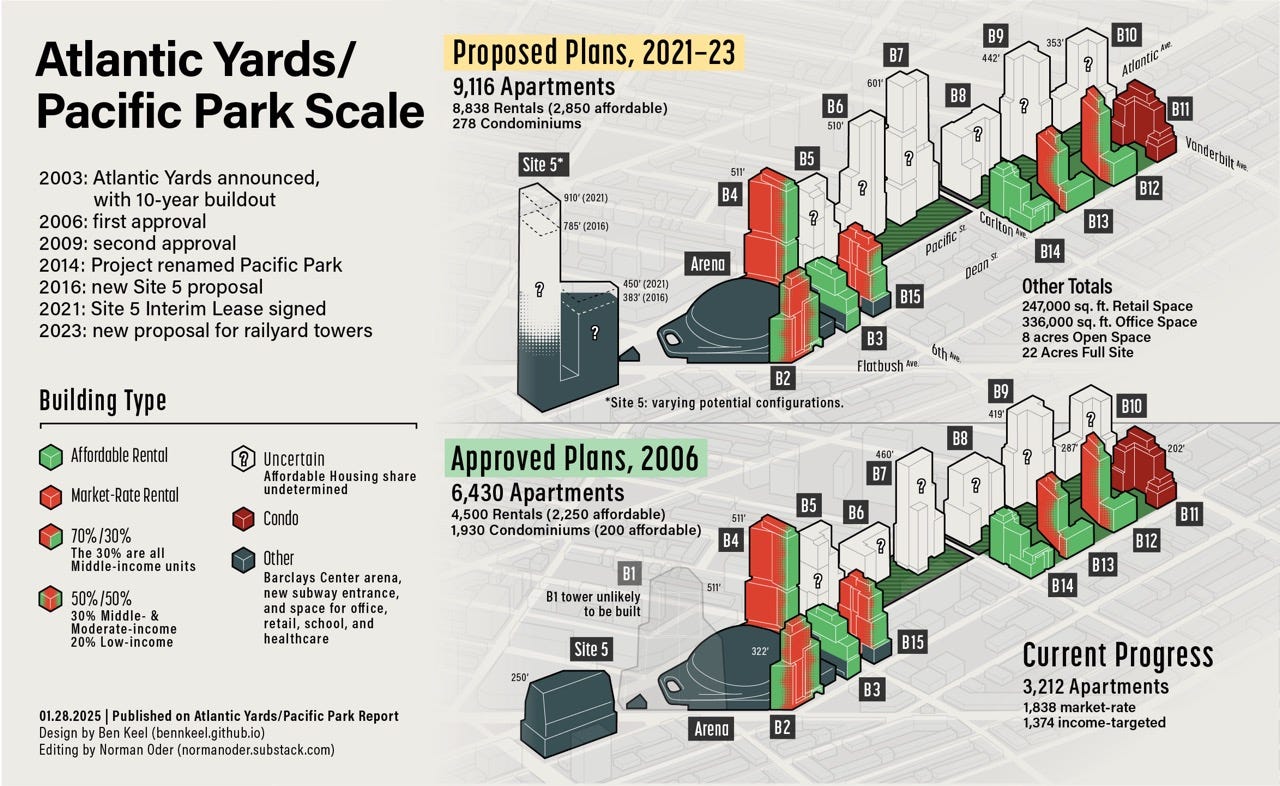
Joe Sitt has been at it for 25 years and keeps failing, thank goodness. Defend Coney Island!